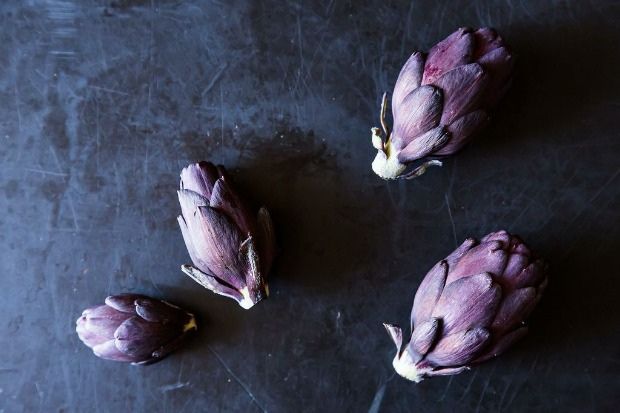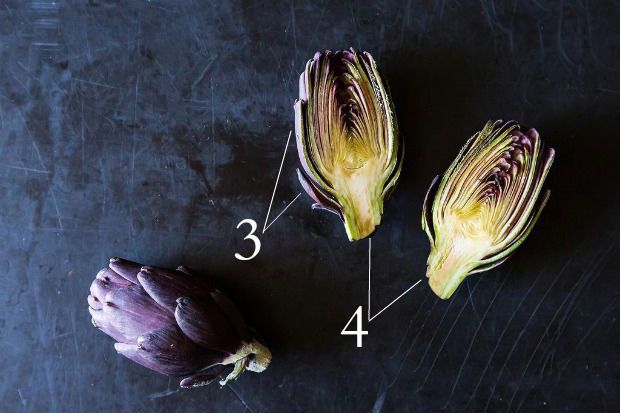Every week we get Down & Dirty, in which we break down our favorite unique seasonal fruits, vegetables, and more.
Baby artichokes aren't really babies -- but they are easy to prep and work into meals from now till next week.

Did you know that baby artichokes aren’t really babies at all? Their petite size is due to their placement on the plant, and isn’t a reflection of their maturity. Artichokes at the top of the plant, with full access to the sun, will be much larger than those at the bottom of the plant (which are shaded by the plant’s leaves).
Artichokes are a member of the sunflower family (along with Jerusalem artichokes and dandelions), and the part we eat is actually an immature flower bud -- that fuzzy choke on top of the artichoke’s heart would have matured into a full flower head if we had let it.

Where to Find Them and What to Look For
Peak season for artichokes is March through May, and then again in the fall. California produces almost all of the artichoke crop in the U.S., so your best bet for acquiring artichokes will be to visit your favorite grocer. Artichokes are grown at a smaller scale elsewhere though, and brought to farmers markets, so check to see if you can find them at a market near you.
Choose artichokes that feel firm -- stem too! (2) -- and heavy for their size (these tips all apply for buying all artichokes -- baby or not). Want to have a little fun at the store? Give your artichoke the sound test. Elizabeth Schneider says it best: “Squeezed, a fresh artichoke protests with a noisy squeak; a flabby one barely mumbles.”
Bracts (what we think of as leaves) should be tightly closed (1); once they open up the artichoke is past its prime. Take a pass on any artichokes with dry or pitted bracts, but it’s okay if they have brown or white streaks and spots -- that’s just due to cold temperatures and wind. The blemishes are purely cosmetic, and they won’t affect the taste. Speaking of taste, you might find that purple artichokes taste a little different from their green counterparts -- slightly stronger or heartier.
More: Not sure how to prep your artichoke? Wonder no more. You’ve got options.

How to Store and Prep
Artichokes should be stored in the refrigerator, wrapped in a wet paper towel. Their appearance won’t change very quickly (giving the illusion that they store well), but they'll lose flavor and firmness over time, so use them up soon after you bring them home!
Baby artichokes make for easier prep, since there’s no choke to remove (and they boast proportionally more heart than bigger artichokes -- bonus!). Just peel away the tougher outer leaves (3), and trim and peel the stem if necessary. Small artichokes (even Mark Bittman finds it nearly impossible to tell the difference between baby and small artichokes just by sight) might have a bit of choke to remove, so just cut them in half (4) and scoop it out -- a grapefruit spoon works well for this. Then drop the trimmed pieces in an acidulated water bath to prevent discoloration. Follow Deborah Madison’s advice, and use a stainless-steel knife to prep, rather than a carbon-steel knife, which can stain the artichoke.
How to Use
Try your artichokes grilled, braised, baked, roasted, or sautéed. But (sorry!) like other purple vegetables, cooking reduces their vibrant hue. Baby artichokes are also great raw (try them shaved in a salad). Here’s our plan for the week:
Friday: Baby Purple Artichokes Fried in Olive Oil
Saturday: Baby Artichoke Crostini
Sunday: Lemon Lamb Shanks with Baby Artichokes
Monday: Baby Artichoke Dinosaur Kale Panzanella
Tuesday: Roasted Baby Artichokes with a Lemon Vinaigrette and Shaved ParmesanWednesday: Spring Quinoa Pilaf with Ramps, Baby Artichokes and Peas
Thursday: Grilled Baby Artichokes with Mint Chimichurri
Photos by James Ransom




See what other Food52 readers are saying.